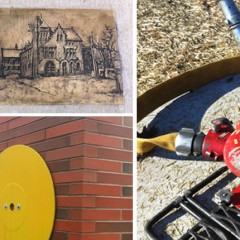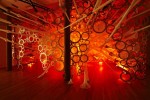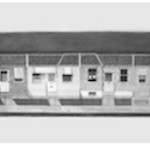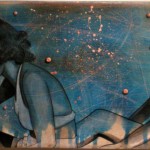A rejuvenated natural world of flora and fauna in the post-human future is presented in Pangaea Ultima, a series of digitally manipulated photographs by Philadelphia artist Nick Pedersen currently up at the Slingluff Gallery.
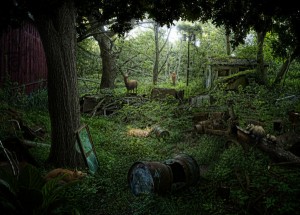
Just as dinosaurs existed at a time when the earth had only one super-continent, dubbed Pangaea, some scientists project that the continuous shifting of tectonic plates will eventually bring the earth’s continents back together to form a new, giant land-mass, “Pangaea ultima,” some 250 million years into the future. Pedersen’s work is a visual interpretation of this idea, where bears, vultures, cats, and bison thrive and roam amongst rusted, crumbling structures and other remnants of civilization.
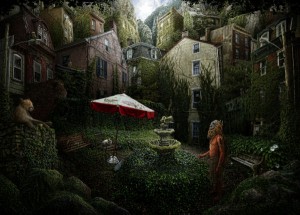
Pedersen stitched together 80 to 100 photographs per image in this series, using his photographs of nature and buildings from Philadelphia, Utah and Japan, as well as of live animals and stuffed ones from the Museum of Natural History in New York, as the raw materials for his work. Everything in the pictures feels alive – even the rock formations – except for the tattered American flag or yard-flamingo, the human objects in decay, and the collapsed buildings with windows resembling ghostly eyes.
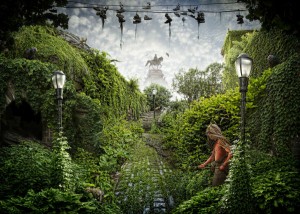
Viewing the complete series, a fragile narrative forms around the red-skinned, masked human who wanders through this landscape, collecting leaves in his rucksack and wearing what looks like recovered fabrics and a semi-circular-bone necklace. This futuristic human survivor passes numerous recognizable sights from the Philadelphia landscape — including the Washington monument by Rudolf Siemering that stands in front of the Philadelphia Museum of Art (above) — to reach a massive lake overlooking rows of Japanese style-homes, implying a future where Japan and Pennsylvania have drifted to border each other.
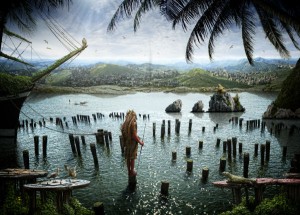
However, to some extent the effect of these images is dampened by the impossibly intact condition of human buildings in a hypothetical future millions of years distant. This is a very optimistic version of that future, where DirectTV satellites still stand and a traffic light still glows red. By comparison, The History Channel’s series “Life After People” projected a level of decay for urban structures equal to that depicted here less than 1,000 years into a human-less reality, with almost no buildings standing for more than 10,000 years without human upkeep.
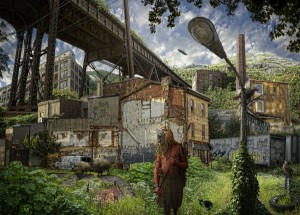
Those quibbles aside, the pieces stand strong as a meditative and resonant series bringing the immortal elements of living nature into elegant juxtaposition with the meaningless shadow of humanity’s impact on the planet. The diverse and beautiful plant-life in particular feels magical and alive in these pieces – futuristic depictions of the earth usually show an arid, post-apocalyptic desert, but here the world is vibrant, green, and alive. Perhaps this show isn’t the scientifically accurate “Pangaea ultima,” but something else – a place of mind where the natural world is one unified body, unobserved by human consciousness.
Pangaea Ultima will be on view at the Slingluff Gallery, located at 11 West Girard Avenue, through July 1.


